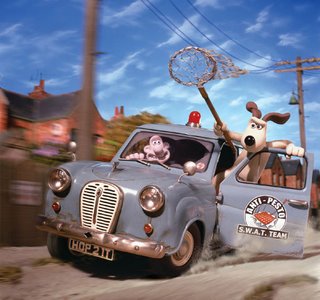 It’s been ten years since the last proper Wallace and Gromit film, 1995’s A Close Shave but time seems to stand still in this most intricate world, with creator and director Nick Park having spent about half of the intervening decade manipulating his plasticine pals for their feature length debut. Occupying a trim terraced house along a red-bricked backstreet of a small Northern English town, a place stuck somehow in a time loop between the present and the 1940s, this beautifully matched duo – the bumbling inventor Wallace and his surefooted pet, Gromit – represent an archetypal chalk-and-cheese double act; a Laurel & Hardy whose cosy familiarity and set routines are as much of a source of their appeal as their cute appearance and gentle humour.Curse of the Were-Rabbit finds the pair, previously astronauts, crime-fighters and sheep-shearers, with a new business venture: Anti-Pesto, a humane pest-control company, which specialises in relocating rabbits whose thirst for greens would otherwise devastate their green-fingered neighbourhoods verdant garden plots. The hotly-contested annual giant vegetable competition is approaching, and Wallace and Gromit are kept busy extracting the plague of pests from the ground with their Bun-Vac 6000, a kind of barnyard Dyson. When Wallace, with his dog’s help, successfully removes the bunnies from the garden of pretty local aristocrat Lady Tottington (Helena Bonham Carter, on her second animated outing this month after Corpse Bride), he gets a flutter of her animated eyelashes for his troubles.
It’s been ten years since the last proper Wallace and Gromit film, 1995’s A Close Shave but time seems to stand still in this most intricate world, with creator and director Nick Park having spent about half of the intervening decade manipulating his plasticine pals for their feature length debut. Occupying a trim terraced house along a red-bricked backstreet of a small Northern English town, a place stuck somehow in a time loop between the present and the 1940s, this beautifully matched duo – the bumbling inventor Wallace and his surefooted pet, Gromit – represent an archetypal chalk-and-cheese double act; a Laurel & Hardy whose cosy familiarity and set routines are as much of a source of their appeal as their cute appearance and gentle humour.Curse of the Were-Rabbit finds the pair, previously astronauts, crime-fighters and sheep-shearers, with a new business venture: Anti-Pesto, a humane pest-control company, which specialises in relocating rabbits whose thirst for greens would otherwise devastate their green-fingered neighbourhoods verdant garden plots. The hotly-contested annual giant vegetable competition is approaching, and Wallace and Gromit are kept busy extracting the plague of pests from the ground with their Bun-Vac 6000, a kind of barnyard Dyson. When Wallace, with his dog’s help, successfully removes the bunnies from the garden of pretty local aristocrat Lady Tottington (Helena Bonham Carter, on her second animated outing this month after Corpse Bride), he gets a flutter of her animated eyelashes for his troubles. Wallace’s rival for the plummy toffs affections is the trigger-happy hunter Lord Victor Quartermaine (hilariously voiced by Ralph Fiennes). In a typically rash act of misplaced genius, the well-meaning Wallace creates a monster when he connects the innocuous Bun-Vac to his other greatest invention, the Heath Robinson-esque Mind-O-Matic, a kind of electrical mind reader, in the hopes of brain-washing the rabbits into not wanting to eat vegetables anymore. The experiment, naturally, backfires, and soon a giant “were-rabbit” stalks the allotments and window boxes of the terrified population.
The film is beautifully written with Park’s understated, natural humour bolstered by co-writer Mark Burton, who penned DreamWorks' Madagascar; a Katzenberg favourite who brings with him that company’s taste for broader comic touches and pop-culture references.
These knowing puns and contemporary gags include the titles of a row of books that hide Wallace's secret cheese stash (like “East of Edam” and “Grated Expectations”.) Another big laugh comes when a snatch of the dreary Art Garfunkel ballad “Bright Eyes” the theme from 70s bunny-disaster cartoon Watership Down, appears on the soundtrack, cuing a perfectly judged stare to camera from a sighing Gromit, breaking the fourth wall in a joke more sophisticated than Park has attempted before. Wallace reads Aye-Up magazine, and fetches his milk from a fridge made by the Smug company. These rib-nudging jokes fit perfectly well in the hermetically sealed universe Park creates, with W&G retaining their own peculiar charm without being corrupted by DreamWorks desire to broaden their appeal as they extend the running-time. They also, thankfully, manage to extend the half-hour, episodic nature of the work into a three act feature, a challenge in itself. The boisterous script keeps things moving briskly from start to finish and displays all the wit we've come to expect. It is smart, snappy, pun laden, and intensely British, glorying in the world of the toolshed inventor, the giant marrow grower and the angry torchlit mob set on destroying the monster.
The glorious stop-motion animation, a process more akin to medieval torture than filmmaking, is astonishing, even by the high standards Park has set himself. His team of artists effortlessly create big, complicated crowd scenes, with a hoard of cute hopping extras and literally hundreds of tiny, individual moving elements. The best of all the jumping bits of plasticine is Gromit’s eyebrow, a tiny roll of brown marla that Parks raises with a maestro’s finesse, giving full voice to the silent Gromit through gesture alone. It’s as if Park is manipulating the fabric of cinema time for his own peculiar comedic aims, with gag after gag relying on split second timing. If that’s something to be admired in real-life, human actors it is cause for amazement when delivered by the deft hands of a model maker working with equal parts patience and inspiration. Park and Aardman have taken the plunge into computer generated images, but these touches are so subtle as to be almost imperceptible and never jar with the consciously clunky foreground action. The voice work is likewise, a treat. The camera moves beautifully through the action, sharply angled from time to time, paying a sweet homage to its camp Hammer Horror influences. The action is supplemented by finely judged genre lighting and a suitably creepy, but never too creepy, soundtrack.
Five years work for an 85 minute children’s film might seem like an awful lot of laborious drudge, but when the results are so good, so true to their origins and suffused with the frame-by-frame glory of cinema, it is worth every second.
 It’s been ten years since the last proper Wallace and Gromit film, 1995’s A Close Shave but time seems to stand still in this most intricate world, with creator and director Nick Park having spent about half of the intervening decade manipulating his plasticine pals for their feature length debut.
It’s been ten years since the last proper Wallace and Gromit film, 1995’s A Close Shave but time seems to stand still in this most intricate world, with creator and director Nick Park having spent about half of the intervening decade manipulating his plasticine pals for their feature length debut. 







2 comments:
corpse bride is a wickedly gleeful banquet of morbid invention :)..
W&G was truly amazing. Loved it. Forgot it was out on DVD now and am going to pick it up on the way home!
Post a Comment